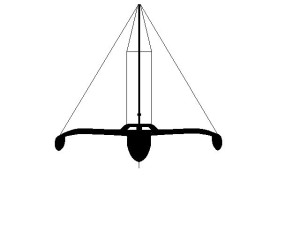 D/T-5
D/T-5
Trimaran, Kelsall
30' x 24' x 1 Ton
18" Dia. Conical Drogue
Force 9-10 Conditions
File D/T-5, obtained from Michael Redvers Golding, Slough, UK. - Vessel name Gazelle, hailing port Poole, Dorset, modified Stripling 28 trimaran designed by Derek Kelsall, LOA 30' x Beam 24' x Draft 4' (12" board up) x 1 Ton - Drogue: Custom-made 18" diameter cone on 200' x 5/8" nylon braid tether, with bridle arms of 40' each - Full trip line - Deployed in a whole gale in mid-Atlantic with winds of 40-50 knots and seas of 30 ft. - Vessel's stern yawed 20° with the helm lashed - Drift was estimated to be about 25 nm during 10 hours of deployment.
Transoceanic racing skipper Mike Redvers Golding has been in many offshore gales. In 1989 his slender racing trimaran Gazelle came to grief off the Shetland Isles during the Round Britain Race. In an article appearing in the December 1989 issue of Multihull, he recounts the harrowing events that led to the loss of his boat (reproduced courtesy of Multihull):
We were only 20 miles off the Shetlands, a lee shore, and 30 miles from our turning point, the infamous Muckle Flugga. Once round the headland we could head off south toward Lerwick.... I would normally have lain to the drogue in these conditions but the lee shore was far too close for comfort. We had spent some time beating, which although painful felt very safe until we could no longer climb the mounting seas.... The noise level rose to fever pitch as Gazelle was picked up by another nasty sea.... It was a slow sickening roll, not at all what I had imagined, with a crash as the port float met the water.... Water rushed below, filling the boat to chest level.... Then came the immortal words, "We've capsized."
Golding and first mate activated the EPIRB and took to a life raft. They were later picked up by a Scottish Search And Rescue helicopter and taken to Lerwick. In the same article Golding writes, "Our proximity to land prevented me from lying to the drogue, although I am sure that this would have prevented the capsize, having ridden out storms with Gazelle which were of equal magnitude, although in the open ocean." Victor Shane contacted Michael Redvers Golding about his previous use of the drogue and Golding then sent the following for inclusion in the DDDB. The drogue was an 18-inch diameter cone, custom made by a sailmaker. Mike used it in an Atlantic gale while participating in the 1988 CSTAR. The cone reduced the speed of the lightweight (2,000 lb.) trimaran from more than 12 knots to about 2.5 knots, with steering generally unnecessary. Transcript:
I have experimented with many methods of lying a-hull and lying to drogues, and must confess that I have reached no definitive conclusion. For simplicity I now consider that there are three basic weather conditions which the skipper must prepare for:
1) HEAVY. It is my opinion that in the event that the weather is unlikely to deteriorate further it is often the safest course of action to sail on with a well prepared boat, an alert helmsman and a linear reduction in sail area.
2) SEVERE. With a multihull it is often necessary to only take the edge off the most extreme turns of speed. In this situation it is prudent to tow warps or lay to a drogue over the stern, which slows the boat to an acceptable speed, preventing surges and reducing the risk of tripping.
3) SURVIVAL. When conditions reach the ultimate for a given craft it seems logical that a strong sea anchor system with a bridle over the bows is the best of a bad lot. As you know survival conditions are rare, though consideration must be given when setting up the boat in the previous category as to whether or not the situation will deteriorate to survival condition, as re-organizing the boat may be both difficult and dangerous.
I will state again that it is my confirmed opinion that Gazelle would not have capsized had we been lying to the drogue. At the time we were too close to a lee shore and the drogue we carried would have only slowed us to around 2.5-3 knots. No doubt there are sea anchors which could have slowed us further, however I doubt that my decision would be much different taking all the factors into account.
Victor Shane forwarded literature on para-anchors to Golding. Had Gazelle been equipped with such a device she would probably have been able to stand off the lee shore, the currents off the Shetlands permitting. The 43-ft. catamaran Ariel did as much in file S/C-6A.